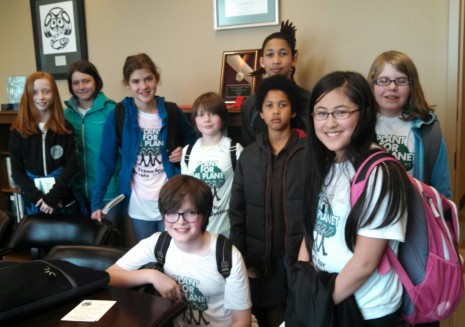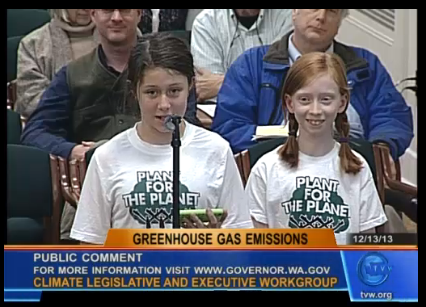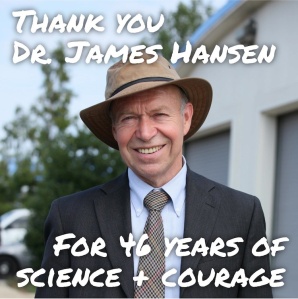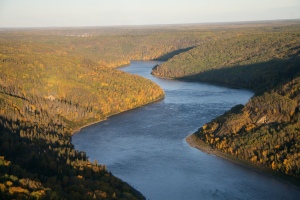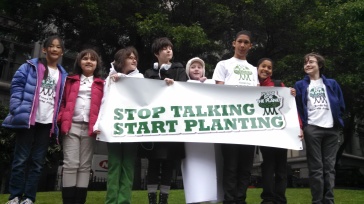
Judge Orders Washington Environmental Agency to Consider Youth-Proposed Carbon Dioxide Reductions
Seattle, Washington – On Tuesday, King County Superior Court Judge Hollis Hill issued a landmark decision in Zoe & Stella Foster v. Washington Department of Ecology, the climate change case brought by eight young citizens of Washington State. In her decision, Judge Hill ordered the Washington Department of Ecology (“Ecology”) to reconsider the petition the eight youth filed with Ecology last year asking for carbon dioxide reductions, and to report back to the court by July 8, 2015, as to whether they will consider the undisputed current science necessary for climate recovery.
Last June, the young petitioners filed a petition for rulemaking to Ecology requesting that the agency promulgate a rule that would limit carbon dioxide emissions in Washington according to what scientists say is needed to protect our oceans and climate system. The youth also asked Ecology to inform the Legislature that existing statutory greenhouse gas reductions must be revised based on current climate science. On August 14, 2014, Ecology denied the petition without disputing the underlying scientific bases for petitioner’s plea. Arguing that they have a fundamental right to a healthy environment, and that they are faced with increasing harms posed by climate destabilization and ocean acidification, the young petitioners filed an appeal of the denial to vindicate this right on behalf of themselves and future generations.
“The effect of this decision is that for the first time in the United States, a court of law has ordered a state agency to consider the most current and best available climate science when deciding to regulate carbon dioxide emissions,” said Andrea Rodgers of the Western Environmental Law Center, attorney for the youth petitioners. “The court directed Ecology to apply the agency’s own findings that climate change presents an imminent threat to Washington and demands immediate action. The ball is now in Ecology’s court to do the right thing and protect our children and future generations.”
In a footnote to her order, Judge Hill explained her plain reasoning for rejecting Ecology’s plan to delay action, referencing a December 2014 report from Ecology: “Ecology suggests no change in greenhouse gas reduction standards until after an international climate conference scheduled in Paris in December 2015, thus delaying action for at least a year from the date of the report or one year and five months after the report’s original due date. Neither in its briefing nor in oral argument of this appeal did the Department seek to justify this suggested delay. The report itself states that after the Paris conference Washington would be better informed how the state’s limits should be adjusted.”
“Kids understand the threats climate change will have on our future,” said 13-year-old petitioner Zoe Foster. “I’m not going to sit by and watch my government do nothing. We don’t have time to waste. I’m pushing my government to take real action on climate, and I won’t stop until change is made.”
The court’s opinion acknowledges that climate change is currently happening and will have devastating impacts on the natural environment of Washington. Citing Ecology’s December report, the court wrote: “Washington State’s existing statutory limits should be adjusted to better reflect the current science. The limits need to be more aggressive in order for Washington to do its part to address climate risks.”
Ecology has recognized that “we are imposing risks on future generations (causing intergenerational inequities) and liability for the harm that will be caused by climate change that we are unable or unwilling to avoid.” Current climate science finds that atmospheric carbon dioxide levels must be reduced from the current global annual mean concentration of 401 parts per million, to 350 ppm by 2100 in order to achieve climate stabilization and protect our oceans from catastrophic acidification.
“This encouraging court decision reminds us that there is still good basis for optimism about legal strategies that aim to require governments to draft an action plan consistent with a more stringent mitigation target than the ones that are commonly discussed,” said the youth’s expert, NASA climate scientist Dr. Pushker Kharecha. “I hope the Department of Ecology realizes that such a plan would be more achievable than they think in this case, and that they will therefore choose to amend their decision accordingly.”
“This is a decision of immense national significance,” said Julia Olson, executive director of Our Children’s Trust, the nonprofit spearheading similar cases around the country. “Judge Hill acknowledges the urgent and dire acceleration of global warming, refuses to accept any more bureaucratic delay, and mandates that the State consider and act in just two weeks time on the youth’s scientific evidence that atmospheric levels of carbon dioxide must be reduced to 350 ppm. This judge understands the role of the judiciary to enforce citizen’s rights to fair evaluation of their grounded petitions and the critical urgency that government act substantively and without delay to protect the state’s resources and the children who depend on them.”
“The court’s decision brings a feeling of triumph,” said 14-year-old petitioner Aji Piper. “But I know there is still a lot of work to be done. We may have one a battle, but we’re still fighting a bigger war.”
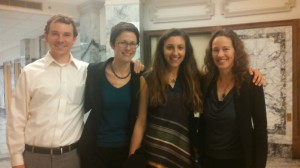
The youth petitioners acted with the help of Our Children’s Trust, an Oregon-based nonprofit orchestrating a global, game-changing, youth-driven legal campaign to establish the right to a healthy atmosphere and stable climate. The legal effort advances the fundamental duty of government today: to address the climate crisis based on scientific baselines and benchmarks, and to do so within timeframes determined by scientific analysis. Our Children’s Trust is a nonprofit organization advocating for urgent emissions reductions on behalf of youth and future generations, who have the most to lose if emissions are not reduced. OCT is spearheading the international human rights and environmental TRUST Campaign to compel governments to safeguard the atmosphere as a “public trust” resource. We use law, film, and media to elevate their compelling voices. Our ultimate goal is for governments to adopt and implement enforceable science-based Climate Recovery Plans with annual emissions reductions to return to an atmospheric carbon dioxide concentration of 350 ppm. http://www.ourchildrenstrust.org/ The Western Environmental Law Center is a public interest nonprofit law firm. WELC combines legal skills with sound conservation biology and environmental science to address major environmental issues throughout the West. WELC does not charge clients and partners for services, but relies instead on charitable gifts from individuals, families, and foundations to accomplish its mission. http://www.westernlaw.org
NOAA, Global Greenhouse Reference Network, Global CO2 for April 2015 (http://www.esrl.noaa.gov/gmd/ccgg/trends/ 1 global.html).
Dr. Pushker Kharecha is a climate scientist at the NASA Goddard Institute for Space Studies (http://www.giss.nasa.gov/ 2 staff/pkharecha.html) and Columbia University Earth Institute (http://www.earth.columbia.edu/eidirectory/displayuser.php? userid=1860).

